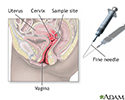Culdocentesis
Culdocentesis is a procedure that checks for abnormal fluid in the space just behind the vagina . This area is called the cul-de-sac.
Vagina
The vagina is the female body part that connects the womb (uterus) and cervix to the outside of the body.

How the Test is Performed
First, you will have a pelvic exam. Then, the health care provider will hold the cervix with an instrument and lift it slightly.
Cervix
The cervix is the lower end of the womb (uterus). It is at the top of the vagina. It is about 2 inches (5 centimeters) long. The cervical canal pa...

A long, thin needle is inserted through the wall of the vagina (just below the uterus). A sample is taken of any fluid found in the space. The needle is pulled out.
How to Prepare for the Test
You may be asked to walk or sit for a short time before the test is done.
How the Test will Feel
You may have an uncomfortable, cramping feeling. You will feel a brief, sharp pain as the needle is inserted.
Why the Test is Performed
This procedure is rarely done today because a transvaginal ultrasound can show fluid behind the uterus.
It may be done when:
- You have pain in the lower abdomen and pelvis, and other tests suggest there is fluid in the area.
-
You may have a ruptured
ectopic pregnancy
or
ovarian cyst
.
Ectopic pregnancy
An ectopic pregnancy is a pregnancy that occurs outside the womb (uterus). It is life-threatening to the mother.
 ImageRead Article Now Book Mark Article
ImageRead Article Now Book Mark ArticleOvarian cyst
An ovarian cyst is a sac filled with fluid that forms on or inside an ovary. This article is about cysts that form during your monthly menstrual cycl...
 ImageRead Article Now Book Mark Article
ImageRead Article Now Book Mark Article
Normal Results
No fluid in the cul-de-sac, or a very small amount of clear fluid, is normal.
What Abnormal Results Mean
Fluid may still be present, even if not seen with this test. You may need other tests.
A sample of fluid may be taken and tested for infection.
If blood is seen in the area, you may need emergency surgery.
Risks
Risks include puncturing the uterine or bowel wall.
Considerations
You may need someone to take you home if you were given medicines to relax.
References
Braen GR. Culdocentesis In: Roberts JR, ed. Roberts and Hedges' Clinical Procedures in Emergency Medicine . 6th ed. Philadelphia, PA: Elsevier Saunders; 2014:chap 57.
Eisinger SH. Culdocentesis (colpocentesis). In: Pfenninger JL, Fowler GC, eds. Pfenninger and Fowler's Procedures for Primary Care . 3rd ed. Philadelphia, PA: Elsevier Mosby; 2011:chap 139.
-
Female reproductive anatomy - illustration
External structures of the female reproductive anatomy include the labium minora and majora, the vagina and the clitoris. Internal structures include the uterus, ovaries and cervix.
Female reproductive anatomy
illustration
-
Culdocentesis - illustration
During a culdocentesis a long thin needle is inserted through the vaginal wall just below the uterus and a sample is taken of the fluid within the abdominal cavity.
Culdocentesis
illustration
-
Cervix needle sample - illustration
Culdocentesis is a procedure which checks for abnormal fluid in the space that is just behind the vagina, the posterior cul-de-sac. This procedure is done when pain occurs in the lower abdomen and pelvic regions, and other tests suggest that fluid may be present in the cul-de-sac. The test may also be done when a ruptured ectopic pregnancy or ovarian cyst is suspected.
Cervix needle sample
illustration
-
Female reproductive anatomy - illustration
External structures of the female reproductive anatomy include the labium minora and majora, the vagina and the clitoris. Internal structures include the uterus, ovaries and cervix.
Female reproductive anatomy
illustration
-
Culdocentesis - illustration
During a culdocentesis a long thin needle is inserted through the vaginal wall just below the uterus and a sample is taken of the fluid within the abdominal cavity.
Culdocentesis
illustration
-
Cervix needle sample - illustration
Culdocentesis is a procedure which checks for abnormal fluid in the space that is just behind the vagina, the posterior cul-de-sac. This procedure is done when pain occurs in the lower abdomen and pelvic regions, and other tests suggest that fluid may be present in the cul-de-sac. The test may also be done when a ruptured ectopic pregnancy or ovarian cyst is suspected.
Cervix needle sample
illustration
Review Date: 4/5/2016
Reviewed By: Irina Burd, MD, PhD, Associate Professor of Gynecology and Obstetrics at Johns Hopkins University School of Medicine, Baltimore, MD. Review provided by VeriMed Healthcare Network. Also reviewed by David Zieve, MD, MHA, Isla Ogilvie, PhD, and the A.D.A.M. Editorial team.



